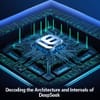DeepSeek, a Chinese AI startup, has been gaining attention for its innovative approach to AI research and development. In this article, Fahim Job explores the architecture and internals of DeepSeek, providing a detailed analysis of its technology.
DeepSeek's architecture is based on a modular design, allowing for flexibility and scalability. The system consists of several components, including a knowledge graph, a semantic search engine, and a natural language processing (NLP) module.
The knowledge graph is a critical component of DeepSeek's architecture, allowing the system to store and manage vast amounts of knowledge. The graph is constructed using a combination of machine learning algorithms and human annotation.
The semantic search engine is another key component of DeepSeek's architecture, enabling the system to search and retrieve relevant information from the knowledge graph. The search engine uses a combination of natural language processing and machine learning algorithms to understand the context and intent of the search query.
DeepSeek's NLP module is also noteworthy, allowing the system to understand and generate human-like language. The module uses a combination of machine learning algorithms and linguistic rules to analyze and generate text.
Overall, DeepSeek's architecture and internals provide a fascinating glimpse into the company's approach to AI research and development. As AI technology continues to evolve, it will be interesting to see how DeepSeek's innovations contribute to the field.


